Podcast: Play in new window | Download (Duration: 18:49 — 14.5MB)
It’s October! Let the spooky monster episodes begin! This week we’re starting off with a bang–or maybe a squoosh–with an episode about globsters. What are they? Why do they look like that? Do they smell?
Yes, they smell. They smell so bad.
Trunko, a globster found in South Africa:
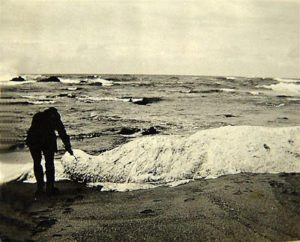
A whale shark:
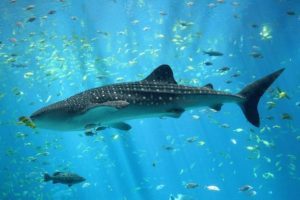
The business end of a whale shark:
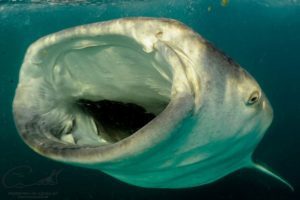
A globster found in Chile:
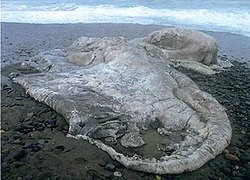
A globster found in North Carolina after a hurricane:
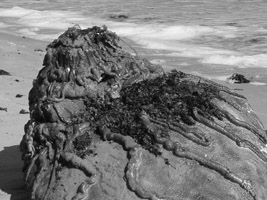
A globster that still contains bones:
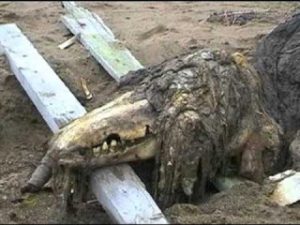
Not precisely a globster but I was only a few weeks late in my 2012 visit to Folly Beach to see this thing:
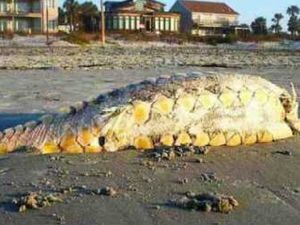
Further reading:
Hunting Monsters by Darren Naish
Show transcript:
Welcome to Strange Animals Podcast. I’m your host, Kate Shaw.
It’s October, and you know what that means! Monsters! …and have I got a creepy monster for you this week. Grab your Halloween candy and a flashlight while I tell you about something called a globster.
If you live near the seashore, or really if you’ve spent any time at all on the beach, you’ll know that stuff washes ashore all the time. You know, normal stuff like jellyfish that can sting you even though they’re dead, pieces of debris that look an awful lot like they’re from shipwrecks, and the occasional solitary shoe with a skeleton foot inside. But sometimes things wash ashore that are definitely weird. Things like globsters.
A globster is the term for a decayed animal carcass that can’t be identified without special study. Globsters often look like big hairy blobs, and are usually white or pale gray or pink in color. Some don’t have bones, but some do. Some still have flippers or other features, although they’re usually so decayed that it’s hard to tell what they really are. And they’re often really big.
Let’s start with three accounts of some of the most famous globsters, and then we’ll discuss what globsters might be and why they look the way they do.
The St. Augustine monster was found by two boys bicycling on Anastasia Island off the coast of Florida in November 1896. It was partially buried in sand, but after the boys reported their finding, people who came to examine it eventually dug the sand away from the carcass. It was 21 feet long, or almost 6.5 meters, 7 feet wide, or just over 2 meters, and at its tallest point, was 6 feet tall, or 1.8 meters. Basically, though, it was just a huge pale pink lump with stumpy protrusions along the sides.
A local doctor, DeWitt Webb, was one of the first people to examine the carcass. He thought it might be the rotten remains of a gigantic octopus and described the flesh as being rubbery and very difficult to cut. Another witness said that pieces of what he took to be parts of the tentacles were also strewn along the beach, separated from the carcass itself.
Dr. Webb sent photographs and notes to a cephalopod expert at Yale, Addison Verrill. He at first thought it might be a squid, but later changed his mind and decided it must be an octopus of enormous proportions—with arms up to 100 feet in length, or over 30 meters.
In January a storm washed the carcass out to sea, but the next tide pushed it back to shore two miles away. Webb sent samples to Verrill, who examined them and decided it was more likely the remains of a sperm whale than a cephalopod.
In 1924, off the coast of South Africa, witnesses saw a couple of orcas apparently fighting a huge white monster covered with long hair—far bigger than a polar bear. It had an appendage on the front that looked like a short elephant trunk. Witnesses said the animal slapped at the orcas with its tail and sometimes reared up out of the water. This went on for three hours.
The battle was evidently too much for the monster, and its corpse washed ashore the next day. It measured 47 feet long in all, or 14.3 meters, and the body was five feet high at its thickest, or 1.5 meters. Its tail was ten feet long, or over three meters, and its trunk was five feet long and over a foot thick, or about 35 cm. It had no legs or flippers. But the oddest thing was that it didn’t seem to have a head either, and there was no blood on the fur or signs of fresh wounds on the carcass.
The carcass was so heavy that a team of 32 oxen couldn’t move it. The reason someone tried to move it was because it stank, and the longer it lay on the beach the more it smelled.
Despite its extraordinary appearance, no scientists came to investigate. After ten days, the tide carried it back out to sea and no one saw it again. Zoologist Karl Shuker has dubbed it Trunko and has written about it in several of his books.
Another globster was discovered well above ordinary high tide on a Tasmanian beach in 1960 after a massive storm. It was 20 feet long, or 6 meters, 18 feet wide, or 5.5 meters, and about 4 ½ feet high at its thickest, or 1.4 meters. It stayed on the beach for at least two years without anyone being especially interested in it. It was in a fairly remote area, admittedly. It wasn’t until 1962 that a team of zoologists examined it. They reported that it was ivory-colored, incredibly tough, boneless, and without any visible eyes. The lump had four large lobes, but it also appeared to have gill slits. One of the zoologists suggested it might be an enormous stingray.
So what were these three globsters?
Let’s look at Trunko first. Shuker points out that when a shark decomposes, it can take on a hairy appearance due to exposed connective tissue fibers. But Trunko was fighting two orcas only hours before it washed ashore.
OR WAS IT??
Here’s the thing. No one saw the fight from up close and orcas are well known to play with their food. There’s a very good chance that Trunko was already long dead and that the orcas came across it and batted it around in a monstrous game of water volleyball. That would also explain why there was no blood associated with the corpse.
In that case, was Trunko a dead shark? At nearly 50 feet long, it would have had to be the biggest shark alive…and as it happens, there is a shark that can reach that length. It’s called the whale shark, which tops out at around 46 feet, or 14 meters, although we do have unverified reports of individuals nearly 60 feet long, or 18 meters—or even longer.
Like the megamouth shark, the whale shark is a filter feeder and its mouth is enormous, some five feet wide, or 1.5 meters. But the interior of its throat is barely big enough to swallow a fish. Its teeth are tiny and useless. Instead, it has sieve-like filter pads that it uses to filter tiny plants and animals from the water, including krill, fish eggs and larvae, small fish, and copepods. The filter pads are black and are probably modified gill rakers. The whale shark either gulps in water or swims forward with its mouth open, and water flows over the filter pads before flowing out through the gills. Tiny animals are directed toward the throat so the shark can swallow them.
The whale shark is gray with light yellow or white spots and stripes, and three ridges along each side. Its sandpaper-like skin is up to four inches thick, or 10 cm. It has thick, rounded fins, especially its dorsal fin, and small eyes that point slightly downward. It usually stays near the surface but it can dive deeply too, and it’s a fast swimmer despite its size. Females give birth to live babies which are a couple of feet long at birth, or 60 cm. While no one has watched a whale shark give birth, researchers think a shark may be pregnant with hundreds of babies at a time, but they mature at different rates and only a few are born at once.
The whale shark isn’t dangerous to humans at all, but humans are dangerous to whale sharks. It’s a protected species, but poachers kill it for its fins, skin, and oil.
The whale shark usually lives in warm water, especially in the tropics, but occasionally one is spotted in cooler areas. They’re well known off the coast of South Africa. If the Trunko globster was a dead whale shark, the “trunk” was probably the tapered end of the tail, with the flukes torn or rotted off. Most likely the jaws had rotted off as well, leaving no sign that the animal had a head or even which end the head should be on.
But sharks aren’t the only big animals in the ocean, and the skin and blubber of a dead whale can also appear furry once it’s broken down sufficiently due to the collagen fibers within it. Collagen is a connective tissue and it’s incredibly tough. It can take years to decay. Tendons, ligaments, and cartilage are mostly collagen, as are bones and blubber.
While we don’t know what Trunko really was, many other globsters that have washed ashore in modern times have been DNA tested and found to be whales. In 1990 the Hebrides blob washed ashore in Scotland. It was 12 feet long, or 3.7 meters, and appeared furry, with a small head at one end and finlike shapes along its back. Despite its weird appearance, DNA analysis revealed it was a sperm whale, or at least part of one. Another sperm whale revealed by DNA testing was the Chilean blob, which washed ashore in Los Muermos, Chile in 2003. It was 39 feet long, or 12 meters.
As for the tissue samples of the St Augustine monster, they still exist, and they’ve been studied by a number of different people with conflicting results. In 1971, a cell biologist from the University of Florida reported that it might be from an octopus. Cryptozoologist Roy Mackal, who was also a biochemist, examined the samples in 1986 and also thought the animal was probably an octopus. A more sophisticated 1995 analysis published in the Biological Bulletin reported that the samples were collagen from a warm-blooded vertebrate—in other words, probably a whale. The same biologist who led the 1995 analysis, Sidney Pierce, followed up in 2004 with DNA and electron microscope analyses of all the globster samples he could find. Almost all of them turned out to be remains of whale carcasses, of various different species. This included the Tasmanian globster.
Sometimes a globster is pretty obviously a whale, but one with a bizarre and unsettling appearance. The Glacier Island globster of 1930, for instance, was found floating in Eagle Bay in Alaska, surrounded by icebergs from the nearby Columbia Glacier. The head and tail were skeletal, but the rest of the body still had flesh on it, although it appeared to be covered with white fur. Its head was flattish and triangular and the tail was long. The men who found the carcass thought it had been frozen in the glacier’s ice.
They hacked the remaining flesh off to use as fishing bait, but they saved the skeleton. A small expedition of foresters came to examine the skeleton, which they measured at 24 feet and one inch, or over 7.3 meters. They identified it as a minke whale. The skeleton was eventually mounted and put on display in a traveling show, advertised as a prehistoric monster found frozen in a glacier. In 1931 the skeleton was donated to the National Museum of Natural History in Washington DC, where it remains in storage. Modern examinations confirm that it’s a minke whale.
On March 22, 2012, a rotting corpse 15 feet long, or 4.6 meters, with armor-like scutes along the length of its body, washed ashore on Folly Beach in South Carolina. This isn’t exactly a globster, since it was still fish-shaped, but I’m including it because I was literally at Folly Beach a matter of weeks after this thing washed ashore. I wish I’d seen it. It turned out that it wasn’t a sea monster as people assumed, but a rare Atlantic sturgeon.
Many globsters have stumps that look like the remains of flippers, legs, or tentacles. The Four Mile Globster that washed ashore on Four Mile Beach, Tasmania in 1998 had protrusions along its sides that looked like stumpy legs. It was 15 feet long, or 4.6 meters, and 6 feet wide, or 1.8 meters, with white hair and flippers that were separate from the protrusions. We don’t actually know for sure what this globster was.
In 1988 a treasure hunter found a globster now called the Bermuda blob. It was about eight feet long, or almost 2.5 meters, pale and hairy with what seemed to be five legs. The discoverer took samples of the massively tough hide, which were examined by Sidney Pierce in his team’s 1995 study of globster remains. This was one of the few that turned out to be from a shark instead of a whale, although we don’t know what species.
But sharks don’t have five legs. And the Four Mile Globster had six stumps that were separate from the flippers still visible on the carcass. So what causes these leg-like protrusions? They’re probably flesh and blubber stiffened inside with a bone or part of a bone, such as a rib. As the carcass is washed around by the ocean, the flesh tears in between the bones, making them look like stumps of appendages.
There’s a good reason why so many globsters turn out to be sperm whale carcasses. A sperm whale’s massive forehead is filled with waxy spermaceti oil. The upper portion of the head contains up to 500 gallons of oil in a cavity surrounded by tough collagen walls. Researchers hypothesize that this oil is used both for buoyancy and to increase the whale’s echolocation abilities. The lower portion of the forehead contains cartilage compartments filled with more oil, which may act as a shock absorber since males in particular ram each other when they fight. So much of the head of a sperm whale, which can be as big as 1/3 of the length of the whale, is basically a big mass of cartilage and connective tissue. After a whale dies, this buoyant section of the body can separate from the much heavier skeleton and float away on its own.
Globsters aren’t a modern phenomenon, either. We have written accounts of what were probably globsters dating back to the 16th century, and older oral traditions from folklore around the world. The main problem with globsters is that they’re not usually studied. They smell bad, they look gross, and they may not stay on the beach for long before the tide washes them back out to sea. For instance, after Hurricane Fran passed through North Carolina in 1996, a group of young men found a globster washed up on a beach on Cape Hatteras. They took pictures and estimated its length as twenty feet long, or six meters, six feet wide, or 1.8 meters, and four feet high at its thickest, or 1.2 meters. From the pictures it’s pretty disgusting, like a lump of meat with intestines or tentacles hanging from it. But the men weren’t supposed to be on the beach, which was part of the Cape Hatteras National Park and closed due to hurricane damage. They didn’t mention their find to anyone until the following year, when one of the men learned about the St Augustine Monster in his college biology class. By then, of course, the Cape Hatteras globster was long gone. While it might have been a rotting blob of whale blubber or a piece of dead shark, we don’t know for sure. So if you happen to find a globster on a beach, make sure to tell a biologist or park ranger so they can examine it…before it’s lost to science forever.
You can find Strange Animals Podcast online at strangeanimalspodcast.com. We’re on Twitter at strangebeasties and have a facebook page at facebook.com/strangeanimalspodcast. If you have questions, comments, or suggestions for future episodes, email us at strangeanimalspodcast@gmail.com. If you like the podcast and want to help us out, leave us a rating and review on Apple Podcasts or whatever platform you listen on. We also have a Patreon if you’d like to support us that way.
Thanks for listening!